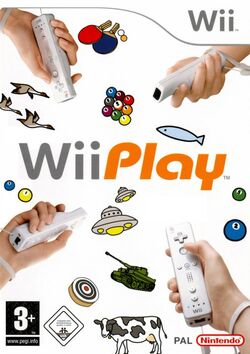To see discussions, please visit the article's votes for featured page.
Wii Play is a party video game developed and published by Nintendo for the Wii. It was released as a launch game for the console in Japan, Europe, and Australia, and was released in North America on February 12, 2007. The sequel to Wii Play, Wii Play: Motion, was released in 2011. Wii Play is part of both Nintendo's Touch! Generations brand and the Wii series.
Wii Play features nine minigames that are designed to introduce players to handling the Wii Remote controller. Like all other titles in the Wii series, the players control Miis.
A beta version of the game was first playable alongside Wii Sports at E3 2006. However, the games were not put together in a pack-in; they were separate games meant to be tech demos. A notable example was Shooting, which was also a demo on the Nintendo Fusion Tour, which spectators thought was a full-fledged Duck Hunt sequel.[1] Nintendo had yet to announce that the tech demos would be compiled together into a full game.
The game was revealed together for the first time on the Nintendo World event in New York on September 14, 2006. It is here where Mii Channel functionality was confirmed to be included in the game. Also included updated versions of the games playable at E3, now closer to their finalized form.[2]
Release dates[]
- North America: February 12, 2007
- Japan: December 2, 2006
- Europe: December 8, 2006
- Australia: December 7, 2006
Gameplay[]
Wii Play consists of nine games, designed for 1 or 2 players, in the 1-player mode, the player will play versus/with a computer-controlled second player in games where it is necessary.
No Nunchuks are required for any of the games; however, players can use a Nunchuk as a substitute for the D-Pad for the "Tanks!" minigame if they wish.
After playing each game another game is unlocked, until all nine games are available. In single player, points are earned in each game and the top 5 highest scores are stored. Getting high enough scores in single player awards the player bronze, silver, gold and platinum medals for that game. It also puts a message on the Wii Message Board saying which game and medal were unlocked, and gives a short tip for that game.
Minigames[]
| Image | Name | Description |
|---|---|---|
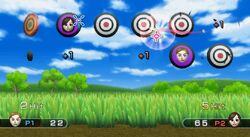
|
Shooting Range | Players go through various rounds of shooting balloons, targets (includes Mii targets; shooting your own Miis results in a deduction of points, shooting the opponents gives you points), Frisbees, soda cans, and UFOs, as the player has to protect the 6 Miis (3 of each in 2 player mode) they are using from being abducted and taken away. There are targets that have the faces of the players' Miis, which give points when the opponent's Mii is shot. Ducks also fly by and can be shot for additional points. Bonus points are awarded for consecutive hits without missing. In Single Player Mode, a second Wii Remote can help player one earn extra points. |

|
Find Mii | Crowds of Miis will gather on the screen, standing, swimming, walking, sitting, and riding down an escalator, and the player is given certain details to look for among them. The player then must pick out the Miis that match the objective. The objectives range among finding two to five identical Miis; finding the fastest Mii; choosing a favorite and finding it again; or finding the "odd Miis out" (doing things that other Miis are not). Single player mode uses a timed system in which the time limit is extended upon finding the correct Mii(s), and multiplayer mode uses a scoring system where two players attempt to get the highest score within two minutes. |
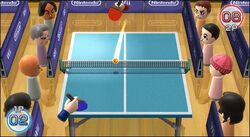
|
Table Tennis | See also: Table Tennis (Wii Sports Resort)
This game is, essentially, a game of table tennis, volleying back and forth by moving the Wii Remote. The Mii characters are supported, and are represented in the audience. As the game progresses, the audience grows larger. Multiplayer mode employs similar gameplay with changing service, sides and a "first to 11" rule. |
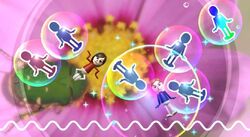
|
Pose Mii | A player must move their Mii to falling bubbles using the Wii Remote pointer. The player must also rotate their Mii to the correct angle of the bubble by rotating the Wii Remote. In addition to this, as the game progresses, the poses inside the bubbles change, and the player must select the correct pose. When a Mii is correctly posed in a bubble, it bursts. If three bubbles are not burst and eventually fall to the floor, the game is over. In multiplayer mode, each player has differently colored bubbles, but players can pop one another's bubbles to earn extra points. Bonuses are awarded for not dropping any bubbles in a round. Multicolored bubbles temporarily freeze time, allowing the player to pop all bubbles on the screen. |
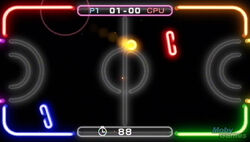
|
Laser Hockey | A remake of the classic game Pong. A Hockey Table game with plenty of bright lights. Player one is on the left side, and is blue, Player two is on the right side, and is red, Player two will also be the computer if you only have one player. |
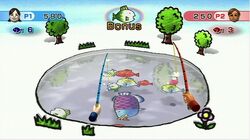
|
Fishing | Players use the Wii Remote as a fishing rod, to hook specific paper fish and then yank upwards to grab them. Points are added and subtracted depending on the fish caught. A display at the top of the screen shows which fish gives bonus points if caught, and changes every 30 seconds or so. |

|
Billiard | Players play a nine ball version of the traditional pool game rotation, with a point scoring system that is quite unlike that of the game of nine-ball. Points are earned corresponding to the number on the object ball that is pocketed (potted), e.g. 2 points for sinking the 2 ball; however, 3 points are deducted from the player's score for each foul shot committed. The game ends when all balls have been pocketed. A player may line up a shot with overhead 2D and behind-the-ball 3D viewpoints. A player can aim for contact anywhere on the cue ball to add spin or execute jump shots, and may change the angle at which the cue strikes the ball. |
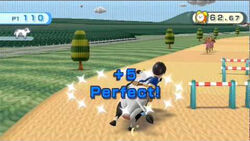
|
Charge! | The player rides a cow and topples scarecrows to accrue points. A time bonus is added upon crossing the finish line, where one second remaining on the timer is equivalent to one point. Jumping scarecrows can be toppled over to acquire more points. This game uses the Wii Remote on the side that the player can increase or decrease the cow's speed, and jump. |
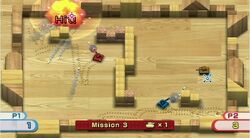
|
Tanks! | In this game, the player controls a small toy tank to destroy enemy tanks in a 2.5D wooden toy block environment. The game is similar to the arcade game Tank. Tanks can fire shells and/or lay mines. All tanks, including the player's, will be destroyed when hit by a single shell or mine. The aim of the game is to destroy all enemy tanks while avoiding their attacks. When this is achieved, play advances to the next level, which will have a different combination of enemy tank types and a differently laid-out block environment. This game does not offer continuation when game over. |
Reception[]
Wii Play received mixed reviews from critics. It received a score of 61.64% on GameRankings and 58/100 on Metacritic. The reviewers at Electronic Gaming Monthly gave the game varying scores of 6.0, 4.5 and 5.0, stating that while "anybody can play it, including grandma,... you'll probably be bored in minutes". gamesTM gave the game a more scathing reaction, scoring it 3/10 stating that "Even the games that do work break down due to a combination of being extremely bland or too repetitive", and even that the strongest game, Shooting, "loses its charm as soon as you realise the targets follow a similar path every time you play". IGN Australia were more positive in their reaction, awarding the game 8.3/10, saying that it was "effectively being sold at $10 on top of the cost of a Wii Remote" and that "as a training game, it succeeds completely".[3]. The Official Nintendo Magazine also praised the game and gave it 91%, describing the games as "surprisingly addictive" as well as citing the value of supplying an additional Wii Remote.
Sales[]
Despite most reviews being mixed, the game has sold very well worldwide. According to Nintendo, the game has sold 28.02 million copies worldwide, as of March 31, 2012, making it the best selling non-bundled game of all time.
References[]
Trivia[]
- If the player puts the Wii Remote on a flat surface, and stays there, the Mii would fall asleep at the Main Menu, however, if two players are using the same thing, their Miis would do the same thing. As the Miis are sleeping, the music changes until they wake up. The sleeping also occurs in Wii Fit, Wii Fit Plus and Wii Fit U, when one or more Miis will fall asleep at the Lobby menu or at the Wii Fit Plus Channel.
| Wii Sports - Wii Sports Resort - Wii Sports Club - Switch Sports Wii Fit - Wii Fit Plus - Wii Fit U |
| Wii Play - Wii Play: Motion |
| Wii Party - Wii Party U |
Others Wii Chess - Wii Music - Wii Karaoke U |

|
|---|
| Predecessor: Nintendo GameCube Successor: Wii U Controllers Wii Remote - Nunchuk - Wii Classic Controller - Wii Classic Controller Pro
Revisions Wii Family Edition - Wii Mini
Other Hardware Optical Disc - SD Card - Wii Sensor Bar - Wii Vitality Sensor - Wii Balance Board - Wii MotionPlus - Nintendo Wi-Fi USB Connector
Software List of Wii Channels - Nintendo Wi-Fi Connection - WiiConnect24 - Virtual Console - Wii Shop Channel - WiiWare
Games
|


